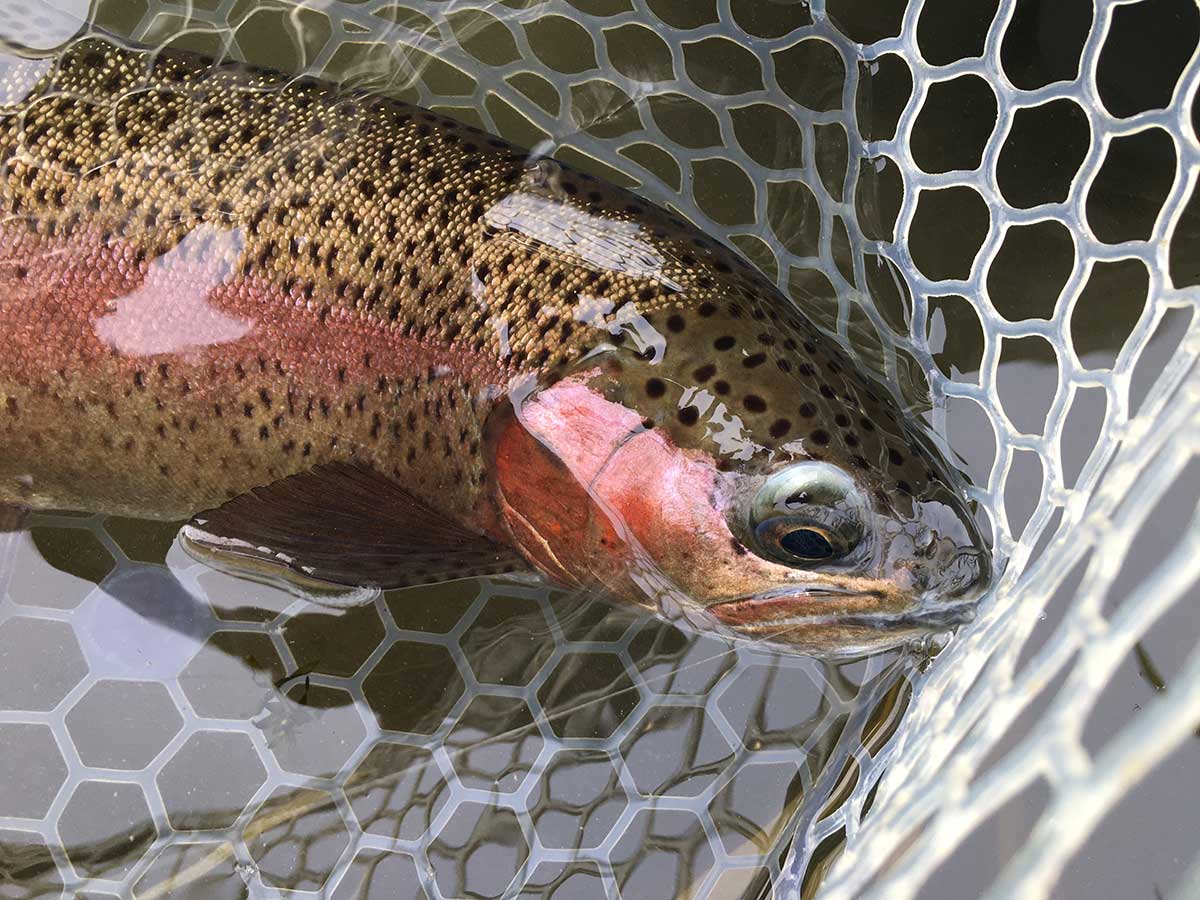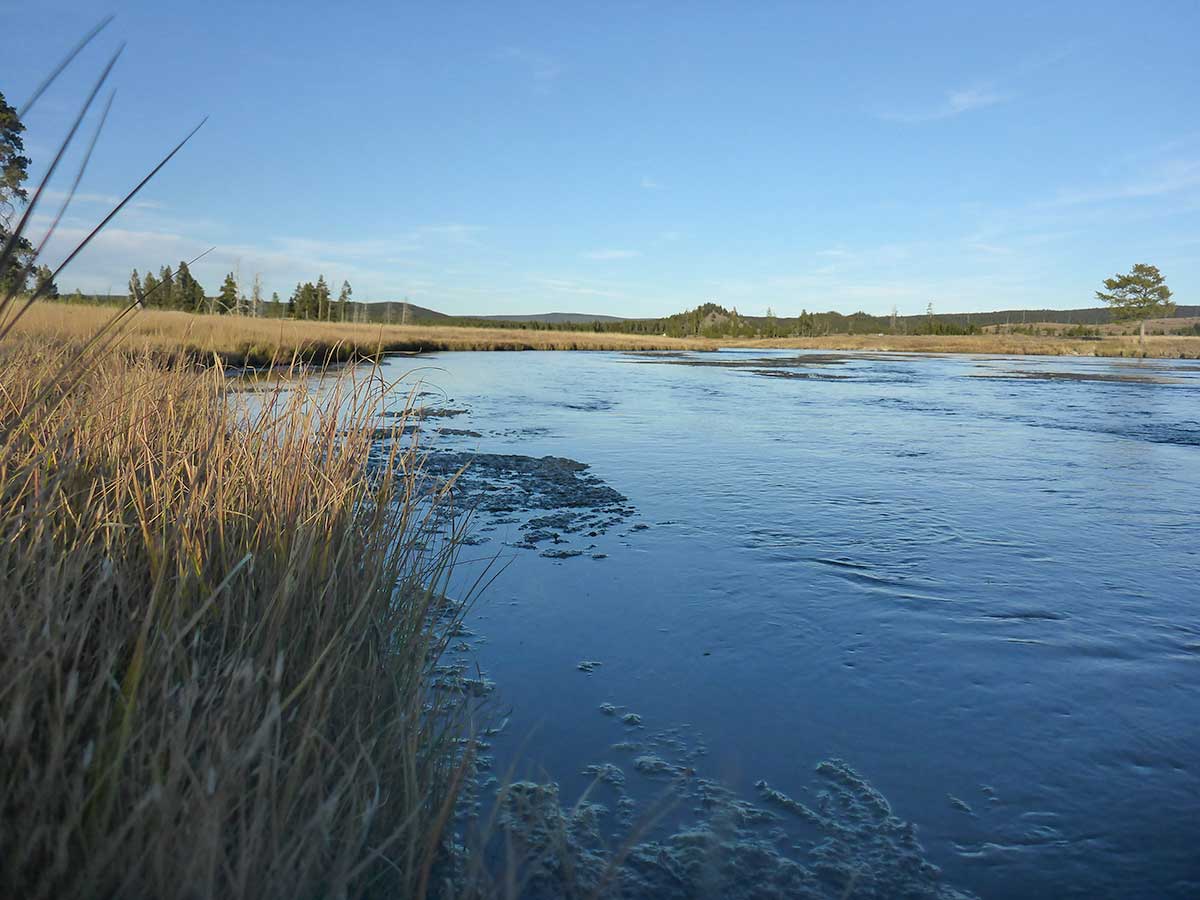Fooling Trout, From Yellowstone to Oregon

Each fall, I spend about three weeks in Yellowstone National Park chasing the big runner brown and rainbow trout that swim up the Madison River from Hebgen Lake.
I fish other spots in Yellowstone as well, especially the Firehole River’s afternoon Blue Wing Olive mayfly hatch.
I’ll spend the morning chasing those big browns on the Madison, and, by lunch, I’m ready to have a picnic on the Firehole and spot some tough rising trout. Now, Firehole River browns and rainbows run a lot smaller than Madison River runners — a 14-incher is a photo fish — but these afternoons aren’t about size.
They’re about fooling tough trout.
On Your Knees
Most Firehole River trout live within eyesight of the road, and that means really good anglers strafe the fish with flies from late May through early July. Most anglers give the river a break in July and August, as runoff from the world’s largest geyser and hot springs fields — including Old Faithful — make the Firehole too warm to fish.
The river cools in September, and the trout weather more waves of really good anglers from a little after Labor Day until fishing ends during the first weekend of November.
The trout — even that little 9-inch brown rising next to that weedbed — know a lot about anglers by the middle of September, and they are picky about dry flies. Soft hackles? Not so much.
This is kind of cool, as the Firehole has lots of wild browns and rainbows, and the river pumps out millions of Blue Wing Olive mayflies — in size 18 to 24 — on every cloudy, rainy or snowy fall afternoon.
So, it’s all about sneaking up on picky, small trout rising among thick weedbeds, gurgling hot springs and rafts of tiny bugs. It’s easy to find the bugs and the trout, but it’s hard to get the fish to eat a dry fly.
What’s not to love about this madness?
I spend a lot of time on my knees, as I like getting close to the fish. I want to drop accurate casts to individual risers — flock shooting just spooks these trout — and I also want to see my tiny fly among the fleets of natural bugs.

I also knot 6X tippet to my leader — about three or four feet of it. Lighter tippet means a more natural drift — and more bites. It also means more lost fish. I’m used to it. I’d rather hook and lose trout than not hook them at all. Fooling the fish is the best part anyway — until you really, really want to land a special fish.
Finally, you also need some flies that look like the naturals — and are visible to you.
That’s where my friend Bucky McCormick comes in. Bucky is one of the brilliant fly tiers at Blue Ribbon Flies in West Yellowstone, Montana, and he creates amazing, easy-to-tie flies that match these tiny bugs.
This year, I started fishing and tying Bucky’s Almost There Baetis. It’s a simple tie that uses 8/0 thread, Superfine dubbing, lemon Wood Duck and EP Trigger Point fibers. Click here to see Bucky tying the fly.
Sometimes I substitute a few fibers of clear Zelon for the tail, which changes the fly from a dry fly to an emerger — at least in my mind. This fly is very easy to tie, even in tiny sizes. And it works.
Firehole fish still reject this fly — if it is the wrong size.
I found a very large Firehole fish this fall in the Fountain Flat section of the river. I guess this brown was about 16 or 17 inches long, which is huge for the Firehole. I got to know this fish very well, as I cast to it each afternoon for an hour or so for a week. This was the kind of fish you think about on long drives — for 10 years afterwards.
I inched into position and crouched on the bank to send short, downstream reach casts to the fish, which liked to rise between a thick weedbed and a deep slot right next to the bank. It was impossible to cover this fish with a regular, upstream cast. I was mostly fishing my leader, which was 12 feet tapering to 5X. I added another four feet of 6X tippet before tying on the fly.
When happy, this big brown rose like a metronome to Blue Wing Olives. I had to match the size of the day’s hatch, which was usually size 22.
I hooked the fish twice. The first time, the trout shot right into that thick weedbed. Ping!
Two days later, he ate a size 22 Almost There Baetis and rolled into the deep slot. I jumped to my feet, got downstream of the fish and coaxed him out of the slot. He wallowed on the surface and lurched upstream. My old Ross Gunnison reel buzzed, and I felt like I had a shot.
Then he rolled under another weedbed. PING.
Home Again
The trout wasn’t in his spot the next day — or for the rest of my trip. I’m sure he found a new, impossible spot to scarf down his lunch. Maybe I’ll find him next year.
Four days after I got back to Oregon, I drove to the Deschutes River. Going fishing right after I got home from three solid weeks of fishing in Yellowstone seemed like a good idea — and it was. Going fishing is almost always the answer.
The Deschutes flowed under a nice overcast, and most of my fellow anglers were in the steelhead runs. I found perfect solitude in a nice backeddy. Well, I wasn’t completely alone — pods of nice redside rainbows were tipping and sipping to Blue Wing Olives. Different river, different state — but the same weather and the same bugs.
I crouched behind a thicket of reed canary grass and watched the trout eat size 20 bugs. I pulled a slightly used Almost There Baetis from the drying patch on my vest. I clipped off the curly bit of 6X and tied the fly to a fresh 6X tippet. I wish I could say that the fly was still damp from the Firehole or the Madison, but it wasn’t.
But it still looked like the right medicine. I gave the fly a short trip to the shake bottle and looked for a fish. When I’m trying to pick out a fish rising in a pod, I find out a bug on the water and watch it until it vanishes in a rise. Then I try to duplicate that drift. Following one bug is also a good way to find subtle risers — the fish that barely wrinkle the water when they eat.
A rainbow — one that was bigger than that brown on the Firehole — sucked down the fly on the second drift. Nothing feels better than having the fly that works. And Deschutes trout are no pushovers.
From Yellowstone all the way to the Deschutes. As I played the trout, I thought about all the Blue Wing Olive hatches that I’ll fish this fall, winter and spring on my Northwest rivers. I thought about how many Almost There Baetis flies I’ll have to tie from size 18 through 24.
I was so happy.











